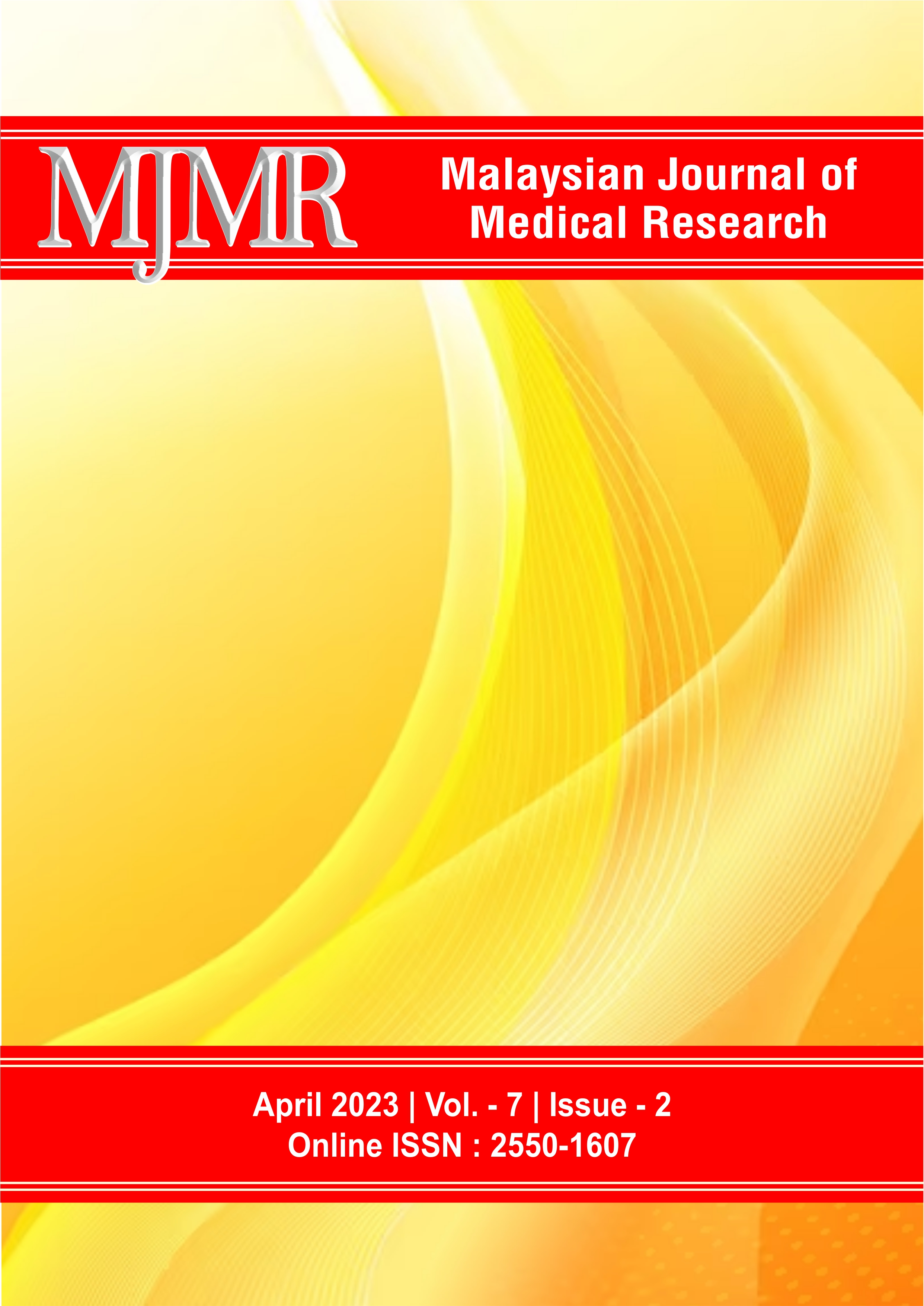The Influence of Basic Life Support Training on the Knowledge, Attitude and Practice of Non-Medical Personnel in Kartika Husada Clinic, Malang East Java, Indonesia
DOI:
https://doi.org/10.31674/mjmr.2023.v07i02.001Abstract
Cardiac arrest refers to the sudden and abrupt loss of heart function. There are many cardiac arrests and only a 14% survival rate due to delays in patient reporting and in giving Basic Life Support (BLS). The purpose of this study was to determine how basic life support (BLS) training affected the knowledge, attitudes, and BLS practices of lay officers at the Kartika Husada Clinic in Malang.
The research design was one group pretest and post-test. The population was all non-medical officers at the Kartika Husada Malang Clinic, totaling 17 people. The sample was 17 respondents using a purposive sampling technique. The research was conducted on 16-17 February 2022 at the Kartika Husada Clinic, Malang. The variables of this study were the knowledge, attitudes and practices of non-medical staff at the Kartika Husada Malang Clinic after providing BLS training interventions.
The statistical test used Wilcoxon and the results show that the knowledge with p-value of 0.02; attitude with p-value of 0.03; and practice p-value of 0.01. These three variables show the effect of BLS training on the knowledge, attitudes and practices of non-medical staff at Kartika Husada Malang Inpatient Clinic. This result was motivated by exposure to previous information, education level, and body mass index.
After this research was conducted and provided training to non-medical staff, it could be applied if they find a heart attack case at the Kartika Husada Clinic.
Keywords:
Attitude, BLS Exercise, Knowledge, PracticeDownloads
References
AHA (2019) Heart Disease and Stroke Statistics., American College of Cardiology. https://www.acc.org/latest-in-cardiology/ten-points-to-remember/2019/02/15/14/39/aha-2019-heart-disease-and-stroke-statistics
Behrend, T., Heineman, J., Wu, L., Burk, C. & Duong, N.T., Munoz, M., Pruett, D., Seropian, M., Dillman, D. (2011). Retention of cardiopulmonary resuscitation skills in medical students utilizing a high-fidelity patient simulator. Medical Student Research Journal. 1-4. http://dx.doi.org/10.15404/msrj.001.001.winter/01
Berg, R. A., Hemphill, R., Abella, B. S., Aufderheide, T. P., Cave, D. M., Hazinski, M. F., Lerner, E. B., Rea, T. D., Sayre, M. R., & Swor, R. A. (2010). Part 5: adult basic life support: 2010 American Heart Association Guidelines for Cardiopulmonary Resuscitation and Emergency Cardiovascular Care. Circulation, 122(18 Suppl 3), S685–S705. https://doi.org/10.1161/CIRCULATIONAHA.110.970939
Chalkias, A., Koutsovasilis, A., Mystrioti, D., Dragoumanos, V., & Xanthos, T. (2013). Outcomes of cardiopulmonary resuscitation efforts in a Greek tertiary hospital. Acute cardiac care, 15(2), 34–37. https://doi.org/10.3109/17482941.2013.781187
Gerungan, W. A. (2009). Psikologi Sosial (Edisi Ketiga). Bandung: PT. Refika Aditama.
Hariza A., (2017). Ilmu Kesehatan Masyarakat. Yogyakarta: Nuhamedika
Hasibuan, M. S. (2009). Manajemen sumber daya manusia, Cetakan ketujuh. Jakarta: PT. Bumi Aksara.
Iqbal, M. W. (2012). Ilmu kesehatan masyarakat konsep dan aplikasi dalam kebidanan. Jakarta: Salemba Medika.
Jaafar, A., Abdulwahab, M., & Al-Hashemi, E. (2015). Influence of Rescuers' Gender and Body Mass Index on Cardiopulmonary Resuscitation according to the American Heart Association 2010 Resuscitation Guidelines. International scholarly research notices, 2015, 246398. https://doi.org/10.1155/2015/246398
Jamil, M., Laksono, B. B., & Merisdawati, M. R. (2021). The Effect Of Cardiopulmonary Resuscitation (CPR) Training On Knowledge, Attitudes And Practices Of Pool Guards. Jurnal Kesehatan Dr. Soebandi, 9(1), 60-66. https://doi.org/10.36858/jkds.v9i1.271
Nori, J. M., Saghafinia, M., Motamedi, M. K., & Hosseini, S. K. (2012). CPR training for nurses: how often is it necessary?. Iranian Red Crescent Medical Journal, 14(2), 104.
Notoatmodjo, S. (2010). Metodologi Penelitian Kesehatan, Rineka Cipta. Jakarta. Indonesia.
Ock, S. M., Kim, Y. M., Chung, J.h, & Kim, S. H. (2011). Influence of physical fitness on the performance of 5-minute continuous chest compression. European journal of emergency medicine : official journal of the European Society for Emergency Medicine, 18(5), 251–256. https://doi.org/10.1097/MEJ.0b013e328345340f
Panchal, A. R., Bartos, J. A., Cabañas, J. G., Donnino, M. W., Drennan, I. R., Hirsch, K. G., Kudenchuk, P. J., Kurz, M. C., Lavonas, E. J., Morley, P. T., O'Neil, B. J., Peberdy, M. A., Rittenberger, J. C., Rodriguez, A. J., Sawyer, K. N., Berg, K. M., & Adult Basic and Advanced Life Support Writing Group (2020). Part 3: Adult Basic and Advanced Life Support: 2020 American Heart Association Guidelines for Cardiopulmonary Resuscitation and Emergency Cardiovascular Care. Circulation, 142(16_suppl_2), S366–S468. https://doi.org/10.1161/CIR.0000000000000916
Peberdy, M. A., Ornato, J. P., Larkin, G. L., Braithwaite, R. S., Kashner, T. M., Carey, S. M., Meaney, P. A., Cen, L., Nadkarni, V. M., Praestgaard, A. H., Berg, R. A., & National Registry of Cardiopulmonary Resuscitation Investigators (2008). Survival from in-hospital cardiac arrest during nights and weekends. JAMA, 299(7), 785–792. https://doi.org/10.1001/jama.299.7.785
Spencer, B., Chacko, J., Sallee, D., & American Heart Association (2011). The 2010 American Heart Association guidelines for cardiopulmonary resuscitation and emergency cardiac care: an overview of the changes to pediatric basic and advanced life support. Critical care nursing clinics of North America, 23(2), 303–310. https://doi.org/10.1016/j.ccell.2011.04.002
Sudjana, N. (2010). Dasar-dasar Proses Belajar, Sinar Baru Bandung.
Trinurhilawati, Martiningsih, Hendari, R., Wulandari, A. (2019) Pengetahuan Bantuan Hidup Dasar dan Keterampilan Tindakan Recovery Position Pada Kader Siaga Bencana. Jurnal Keperawatan Terpadu. 1(1) 78-85. https://doi.org/10.32807/jkt.v1i1.31
Wahit, I.M. (2012) Ilmu Kesehatan Masyarakat Konsep dan Aplikasi dalam Kebidanan. Jakarta: Salemba Medika.
Wawan, A., & Dewi, M. (2010). Teori dan pengukuran pengetahuan, sikap dan perilaku manusia. Yogyakarta: Nuha Medika, 12.
Yamada, K., Kinugasa, Y., Sota, T., Miyagi, M., Sugihara, S., Kato, M., & Yamamoto, K. (2016). Inspiratory muscle weakness is associated with exercise intolerance in patients with heart failure with preserved ejection fraction: a preliminary study. Journal of cardiac failure, 22(1), 38-47. https://doi.org/10.1016/j.cardfail.2015.10.010
Yunanto, R. A., Wihastuti, T. A., & Rachmawati, S. D. (2017). Comparison 0f Cpr Training With Mobile Application And Simulation To Knowledge And Skill Of Cpr, NurseLine Journal, 2(2), 183–193. https://doi.org/10.19184/nlj.v2i2.5943
Published
How to Cite
Issue
Section
License
Copyright (c) 2023 Malaysian Journal of Medical Research (MJMR)

This work is licensed under a Creative Commons Attribution-NonCommercial-NoDerivatives 4.0 International License.























